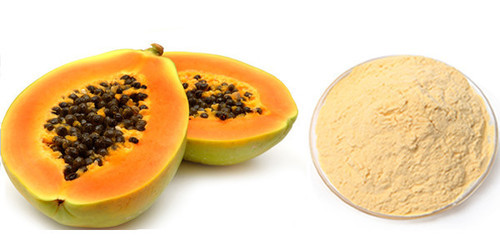Project Report For Papain From Papaya
Introduction
Project report for papain from papaya is as follows.
The cysteine proteinase family includes the proteolytic enzyme papain. Because papayas are so incredibly rich in papain, it is produced from the latex of raw papaya fruits. The green papaya exudes what is known as latex, a milky fluid that contains papain. The papain is more active when the fruit is greener. The papain enzyme adds a lot of benefit. As a step toward forward integration, this project should ideally be taken on by a forward-thinking papaya grower.

Product & Application of Papain From Papaya
It has a strong capability for hydrolyzing proteins. There are several industries that employ papain. Papain is currently most commonly used in the food industry, primarily to cold-proof beer, tenderize meat, and liberate food proteins. Other uses include the tanning of leather and hides, the degumming of silk, the production of cheese, the treatment of vegetable proteins, the processing of fish hydrolyzates, the processing of fish protein concentrates, the processing of fish meals, the pharmaceutical, fragrance, and aroma industries, the processing of effluent, etc.
Raw papaya serves as the main raw ingredient. Papain can be preserved with potassium meta bisulfate or other preservatives. In addition, packaging supplies of food-grade quality will be needed as needed.
Project Report Sample On
Papain From Papaya
Get Completely Custom Bankable Project Report
Manufacturing Process of Papain From Papaya
The white milky latex is removed in the early morning by cutting deep, longitudinal slices through the green, fully formed papaya fruits using sharp, wooden, or stainless steel blades. The latex that has coagulated on the fruit’s surface is scraped off and collected in stainless steel trays. A fruit receives six taps on average over a period of 16 days. To eliminate debris, this latex is passed through 50 grit sieves, mixed with potassium meta bisulfate, spread out on trays, and dried in a vacuum shield drier at a temperature of roughly 55 °C for four to five hours.
The dried product is placed in airtight containers and kept cool and dry. It should be stored in flake form because powdering reduces the product’s stability during storage. To obtain BPC-grade papain, dried flakes are pulverized and diluted with lactose powder. Because metal containers reduce enzyme activity, crude papain flakes or powder should be packed in plastic containers. Transportation is particularly crucial since papain must be maintained below 20° C to maintain its shelf life.
It has a shelf life of 5-6 months if stored and handled properly. The recovery rate of BPC grade papain is between 25% and 30%. In other words, it takes 100 kgs of good quality latex to generate 25-30 kgs of BPC grade papain. The product’s technical know-how was developed by CFTRI, Mysore.
Market Potential Of Papain From Papaya
The papain market is expected to reach $ 371.8 million by 2026, increasing at a CAGR of 4.9% between 2021 and 2026.
Expenses

Product Cost Breakup

Reveneue Vs Expenses

Market Trend

Rising consumer health concerns, high demand for meat tenderizers, and rising need for natural enzymes are some of the major factors driving the growth of the global papain market. To counteract this, papain market participants are spending on research & development and manufacture of papain to meet regulatory specifications as demand grows. Some macroeconomic factors influencing the worldwide papain market include rising population, fast urbanization, and rising domestic income. Mergers and acquisitions between papain producers and papaya suppliers have been highlighted as a trend in the global papain business.
The company producing papain goods has a significant opportunity in regions such as North America, Europe, and Asia Pacific due to the strong demand for natural enzymes and growing health consciousness among a large population. Companies can benefit greatly from collaboration with raw material suppliers, such as papaya vendors, and backward integration in the industry, as raw material, is a critical component of the market.

